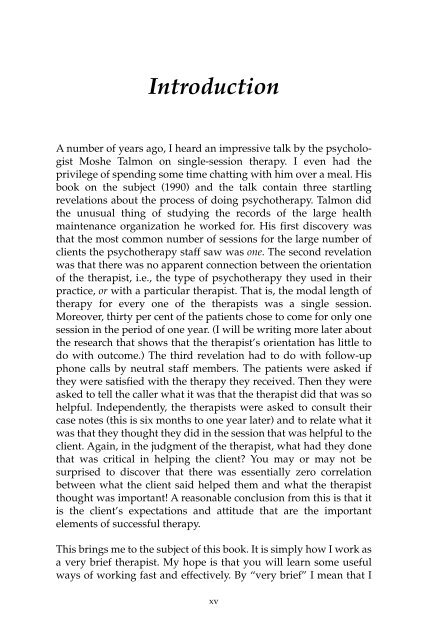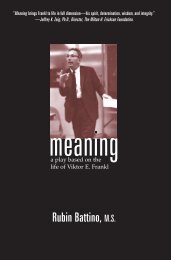Expectation
Look Inside - Crown House Publishing.
Look Inside - Crown House Publishing.
Create successful ePaper yourself
Turn your PDF publications into a flip-book with our unique Google optimized e-Paper software.
IntroductionA number of years ago, I heard an impressive talk by the psychologistMoshe Talmon on single-session therapy. I even had theprivilege of spending some time chatting with him over a meal. Hisbook on the subject (1990) and the talk contain three startlingrevelations about the process of doing psychotherapy. Talmon didthe unusual thing of studying the records of the large healthmaintenance organization he worked for. His first discovery wasthat the most common number of sessions for the large number ofclients the psychotherapy staff saw was one. The second revelationwas that there was no apparent connection between the orientationof the therapist, i.e., the type of psychotherapy they used in theirpractice, or with a particular therapist. That is, the modal length oftherapy for every one of the therapists was a single session.Moreover, thirty per cent of the patients chose to come for only onesession in the period of one year. (I will be writing more later aboutthe research that shows that the therapist’s orientation has little todo with outcome.) The third revelation had to do with follow-upphone calls by neutral staff members. The patients were asked ifthey were satisfied with the therapy they received. Then they wereasked to tell the caller what it was that the therapist did that was sohelpful. Independently, the therapists were asked to consult theircase notes (this is six months to one year later) and to relate what itwas that they thought they did in the session that was helpful to theclient. Again, in the judgment of the therapist, what had they donethat was critical in helping the client? You may or may not besurprised to discover that there was essentially zero correlationbetween what the client said helped them and what the therapistthought was important! A reasonable conclusion from this is that itis the client’s expectations and attitude that are the importantelements of successful therapy.This brings me to the subject of this book. It is simply how I work asa very brief therapist. My hope is that you will learn some usefulways of working fast and effectively. By “very brief” I mean that Ixv
















